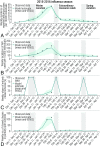Reactive school closure weakens the network of social interactions and reduces the spread of influenza
- PMID: 31209042
- PMCID: PMC6613079
- DOI: 10.1073/pnas.1821298116
Reactive school closure weakens the network of social interactions and reduces the spread of influenza
Abstract
School-closure policies are considered one of the most promising nonpharmaceutical interventions for mitigating seasonal and pandemic influenza. However, their effectiveness is still debated, primarily due to the lack of empirical evidence about the behavior of the population during the implementation of the policy. Over the course of the 2015 to 2016 influenza season in Russia, we performed a diary-based contact survey to estimate the patterns of social interactions before and during the implementation of reactive school-closure strategies. We develop an innovative hybrid survey-modeling framework to estimate the time-varying network of human social interactions. By integrating this network with an infection transmission model, we reduce the uncertainty surrounding the impact of school-closure policies in mitigating the spread of influenza. When the school-closure policy is in place, we measure a significant reduction in the number of contacts made by students (14.2 vs. 6.5 contacts per day) and workers (11.2 vs. 8.7 contacts per day). This reduction is not offset by the measured increase in the number of contacts between students and nonhousehold relatives. Model simulations suggest that gradual reactive school-closure policies based on monitoring student absenteeism rates are capable of mitigating influenza spread. We estimate that without the implemented reactive strategies the attack rate of the 2015 to 2016 influenza season would have been 33% larger. Our study sheds light on the social mixing patterns of the population during the implementation of reactive school closures and provides key instruments for future cost-effectiveness analyses of school-closure policies.
Keywords: influenza; mixing patterns; network science; school-closure strategies.
Copyright © 2019 the Author(s). Published by PNAS.
Conflict of interest statement
The authors declare no conflict of interest.
Figures





References
-
- Hardelid P., et al. , Assessment of baseline age-specific antibody prevalence and incidence of infection to novel influenza A/H1N1 2009. Health Technol. Assess. 14, 115–192 (2010). - PubMed
Publication types
MeSH terms
Grants and funding
LinkOut - more resources
Full Text Sources
Medical

